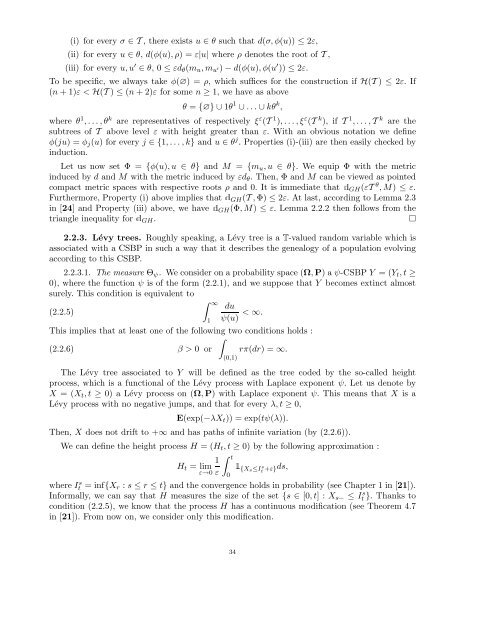arbres aléatoires, conditionnement et cartes planaires - DMA - Ens
arbres aléatoires, conditionnement et cartes planaires - DMA - Ens
arbres aléatoires, conditionnement et cartes planaires - DMA - Ens
Create successful ePaper yourself
Turn your PDF publications into a flip-book with our unique Google optimized e-Paper software.
(i) for every σ ∈ T , there exists u ∈ θ such that d(σ,φ(u)) ≤ 2ε,<br />
(ii) for every u ∈ θ, d(φ(u),ρ) = ε|u| where ρ denotes the root of T ,<br />
(iii) for every u,u ′ ∈ θ, 0 ≤ εd θ (m u ,m u ′) − d(φ(u),φ(u ′ )) ≤ 2ε.<br />
To be specific, we always take φ(∅) = ρ, which suffices for the construction if H(T ) ≤ 2ε. If<br />
(n + 1)ε < H(T ) ≤ (n + 2)ε for some n ≥ 1, we have as above<br />
θ = {∅} ∪ 1θ 1 ∪ ... ∪ kθ k ,<br />
where θ 1 ,... ,θ k are representatives of respectively ξ ε (T 1 ),... ,ξ ε (T k ), if T 1 ,... , T k are the<br />
subtrees of T above level ε with height greater than ε. With an obvious notation we define<br />
φ(ju) = φ j (u) for every j ∈ {1,... ,k} and u ∈ θ j . Properties (i)-(iii) are then easily checked by<br />
induction.<br />
L<strong>et</strong> us now s<strong>et</strong> Φ = {φ(u),u ∈ θ} and M = {m u ,u ∈ θ}. We equip Φ with the m<strong>et</strong>ric<br />
induced by d and M with the m<strong>et</strong>ric induced by εd θ . Then, Φ and M can be viewed as pointed<br />
compact m<strong>et</strong>ric spaces with respective roots ρ and 0. It is immediate thatGH(εT θ ,M) ≤ ε.<br />
Furthermore, Property (i) above implies thatGH(T ,Φ) ≤ 2ε. At last, according to Lemma 2.3<br />
in [24] and Property (iii) above, we haveGH(Φ,M) ≤ ε. Lemma 2.2.2 then follows from the<br />
triangle inequality forGH.<br />
□<br />
2.2.3. Lévy trees. Roughly speaking, a Lévy tree is a T-valued random variable which is<br />
associated with a CSBP in such a way that it describes the genealogy of a population evolving<br />
according to this CSBP.<br />
2.2.3.1. The measure Θ ψ . We consider on a probability space (Ω,P) a ψ-CSBP Y = (Y t ,t ≥<br />
0), where the function ψ is of the form (2.2.1), and we suppose that Y becomes extinct almost<br />
surely. This condition is equivalent to<br />
∫ ∞<br />
du<br />
(2.2.5)<br />
ψ(u) < ∞.<br />
This implies that at least one of the following two conditions holds :<br />
∫<br />
(2.2.6) β > 0 or rπ(dr) = ∞.<br />
1<br />
(0,1)<br />
The Lévy tree associated to Y will be defined as the tree coded by the so-called height<br />
process, which is a functional of the Lévy process with Laplace exponent ψ. L<strong>et</strong> us denote by<br />
X = (X t ,t ≥ 0) a Lévy process on (Ω,P) with Laplace exponent ψ. This means that X is a<br />
Lévy process with no negative jumps, and that for every λ,t ≥ 0,<br />
E(exp(−λX t )) = exp(tψ(λ)).<br />
Then, X does not drift to +∞ and has paths of infinite variation (by (2.2.6)).<br />
We can define the height process H = (H t ,t ≥ 0) by the following approximation :<br />
1<br />
H t = lim<br />
ε→0 ε<br />
∫ t<br />
0½{X s≤I s t +ε} ds,<br />
where It s = inf{X r : s ≤ r ≤ t} and the convergence holds in probability (see Chapter 1 in [21]).<br />
Informally, we can say that H measures the size of the s<strong>et</strong> {s ∈ [0,t] : X s− ≤ It s }. Thanks to<br />
condition (2.2.5), we know that the process H has a continuous modification (see Theorem 4.7<br />
in [21]). From now on, we consider only this modification.<br />
34

















